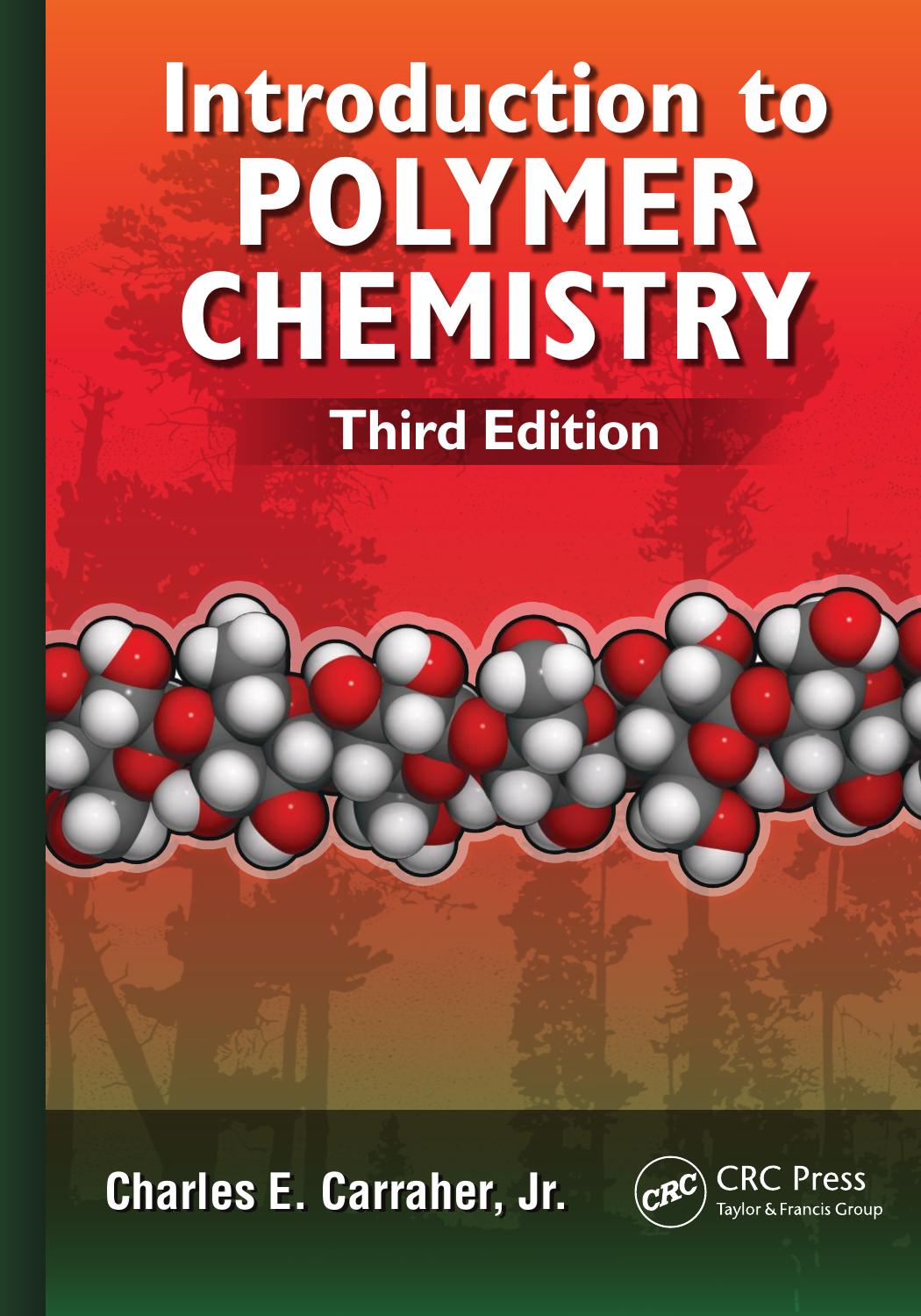
书籍简介
- Introduction to Polymers
- Polymer Structure (Morphology)
- Molecular Weight of Polymers
- Naturally Occurring Polymers
- Step-Reaction Polymerization (Polycondensation Reactions)
- Ionic Chain-Reaction and Complex Coordination Polymerization (Addition Polymerization)
- Free Radical Chain Polymerization (Addition Polymerization)
- Copolymerization
- Organometallic and Metalloid Polymers
- Inorganic Polymers
- Reactions of Polymers
- Testing and Spectrometric Characterization of Polymers
- Rheology and Physical Tests
- Additives
- Synthesis of Reactants and Intermediates for Polymers
- Polymer Technology
本书pdf是文字版,书签良好。
Introduction to Polymers
1.1 History of Polymers
1.2 Why Polymers?
1.3 Today’s Marketplace
1.4 Environmental Assessment
1.5 Managing Sustainability
1.6 Summary
Polymer Structure (Morphology)
2.1 Stereochemistry of Polymers
2.2 Molecular Interactions
2.3 Polymer Crystals
2.4 Amorphous Bulk State
2.5 Polymer Structure–Property Relationships
2.6 Crystalline and Amorphous Combinations
2.7 Cross-linking
2.8 Summary
Molecular Weight of Polymers
3.1 Introduction
3.2 Solubility
3.3 Average Molecular Weight Values
3.4 Fractionation of Polydisperse Systems
3.5 Chromatography
3.6 Colligative Molecular Weights
3.7 Light-Scattering Photometry
3.8 Other Techniques
3.9 Viscometry
3.10 Summary
Naturally Occurring Polymers
4.1 Polysaccharides
4.2 Cellulose
4.3 Cellulose-Regenerating Processes
4.4 Esters and Ethers of Cellulose
4.5 Starch
4.6 Other Polysaccharides
4.7 Proteins
4.8 Nucleic Acids
4.9 Naturally Occurring Polyisoprenes and Other Synthetic Elastomers
4.10 Lignin
4.11 Melanins
4.12 Polymer Structure
4.13 Genetic Engineering
4.14 DNA Profiling
4.15 Asphalt
4.16 Summary
Step-Reaction Polymerization (Polycondensation Reactions)
5.1 Comparison between Polymer Type and Kinetics of Polymerization
5.2 Introduction
5.3 Stepwise Kinetics
5.4 Polycondensation Mechanisms
5.5 Polyesters and Polycarbonates
5.6 Synthetic Polyamides
5.7 Polyimides
5.8 Polybenzimidazoles and Related Polymers
5.9 Polyurethanes and Polyureas
5.10 Polysulfides
5.11 Polyethers
5.12 Polysulfones
5.13 Poly(Ether Ether Ketone) and Polyketones
5.14 Phenolic and Amino Plastics
5.15 Synthetic Routes
5.16 Liquid Crystals
5.17 Microfibers
5.18 Summary
Ionic Chain-Reaction and Complex Coordination Polymerization (Addition Polymerization)
6.1 Cationic Polymerization
6.2 Anionic Polymerization
6.3 Stereoregularity and Stereogeometry
6.4 Polymerization with Complex Coordination Catalysts
6.5 Soluble Stereoregulating Catalysis
6.6 Polyethylenes
6.7 Polypropylene
6.8 Polymers from 1,4-Dienes
6.9 Polyisobutylene
6.10 Metathesis Reactions
6.11 Zwitterionic Polymerization
6.12 Isomerization Polymerization
6.13 Precipitation Polymerization
6.14 Summary
Free Radical Chain Polymerization (Addition Polymerization)
7.1 Initiators for Free Radical Chain Polymerization
7.2 Mechanism for Free Radical Chain Polymerization
7.3 Chain Transfer
7.4 Polymerization Techniques
7.5 Fluorine-Containing Polymers
7.6 Polystyrene
7.7 Poly(Vinyl Chloride)
7.8 Poly(Methyl Methacrylate)
7.9 Polyacrylonitrile
7.10 Solid-State Irradiation Polymerization
7.11 Plasma Polymerizations
7.12 Summary
Copolymerization
8.1 Kinetics of Copolymerization
8.2 The Q–e Scheme
8.3 Commercial Copolymers
8.4 Block Copolymers
8.5 Graft Copolymers
8.6 Elastomers
8.7 Blends
8.8 Polymer Mixtures: IPNS and Alloys
8.9 Dendrites
8.10 Ionomers
8.11 Fluoroelastomers
8.12 Nitrile Rubber
8.13 Acrylonitrile Butadiene Styrene Terpolymers
8.14 EPDM Rubber
8.15 Summary
Organometallic and Metalloid Polymers
9.1 Introduction
9.2 Inorganic Reaction Mechanisms
9.3 Condensation Organometallic Polymers
9.4 Coordination Polymers
9.5 Addition Polymers
9.6 Summary
Inorganic Polymers
10.1 Introduction
10.2 Portland Cement
10.3 Other Cements
10.4 Silicates
10.5 Silicon Dioxide (Amorphous)
10.6 Sol–Gel
10.7 Silicon Dioxide (Crystalline Forms): Quartz Forms
10.8 Silicon Dioxide in Electronic Chips
10.9 Asbestos
10.10 Fly Ash and Aluminosilicates
10.11 Polymeric Carbon: Diamond
10.12 Polymeric Carbon: Graphite
10.13 Internal Cyclization: Carbon Fibers and Related Materials
10.14 Carbon Nanotubes
10.15 Bitumens
10.16 Carbon Black
10.17 Polysulfur
10.18 Ceramics
10.19 High-Temperature Superconductors
10.20 Zeolites
10.21 Summary
Reactions of Polymers
11.1 Reactions with Polyolefins and Polyenes
11.2 Reactions of Aromatic and Aliphatic Pendant Groups
11.3 Degradation
11.4 Cross-Linking
11.5 Reactivities of End Groups
11.6 Supramolecules and Self-Assembly
11.7 Transfer and Retention of Oxygen
11.8 Nature’s Macromolecular Catalysts
11.9 Photosynthesis
11.10 Mechanisms of Energy Physical Absorption
11.11 Breakage of Polymeric Materials
11.12 Summary
Testing and Spectrometric Characterization of Polymers
12.1 Spectronic Characterization of Polymers
12.2 Surface Characterization
12.3 Amorphous Region Determinations
12.4 Thermal Analysis
12.5 Thermal Property Tests
12.6 Flammability
12.7 Electrical Properties: Theory
12.8 Electric Measurements
12.9 Weatherability
12.10 Optical Properties Tests
12.11 Chemical Resistance
12.12 Summary
Rheology and Physical Tests
13.1 Rheology
13.2 Typical Stress–Strain Behavior
13.3 Stress–Strain Relationships
13.4 Specific Physical Tests
13.5 Summary
Additives
14.1 Fillers
14.2 Reinforcements
14.3 Nanocomposites
14.4 Plasticizers
14.5 Antioxidants
14.6 Heat Stabilizers
14.7 Ultraviolet Stabilizers
14.8 Flame Retardants
14.9 Colorants
14.10 Curing Agents
14.11 Antistatic Agents: Antistats
14.12 Chemical Blowing Agents
14.13 Compatibilizers
14.14 Impact Modifiers
14.15 Processing Aids
14.16 Lubricants
14.17 Microorganism Inhibitors
14.18 Summary
Synthesis of Reactants and Intermediates for Polymers
15.1 Monomer Synthesis from Basic Feedstocks
15.2 Reactants for Step-Reaction Polymerization
15.3 Synthesis of Vinyl Monomers
15.4 Summary
Polymer Technology
16.1 Polymer Processing
16.2 Secondary Structures: Mesophases
16.3 Fibers
16.4 Elastomers
16.5 Films and Sheets
16.6 Polymeric Foams
16.7 Reinforced Plastics (Composites) and Laminates
16.8 Molding
16.9 Casting
16.10 Extrusion
16.11 Coatings
16.12 Adhesives
16.13 Conductive Polymeric Materials
16.14 Drug Design and Activity
16.15 Synthetic Biomedical Polymers
16.16 Dental Materials
16.17 Emerging Polymers
16.18 Green Materials
16.19 Summary
Comments !